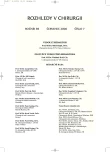-
Medical journals
- Career
Atypically Localised Hepatic Haemangioma as a Cause of Dyspeptic Syndrome
Authors: J. Pudil 1; J. Martínek 2; T. Belšan 3; M. Ryska 1
Authors‘ workplace: Chirurgická klinika 2. LF UK a ÚVN Praha, přednosta prof. MUDr. M. Ryska, CSc. 1; Oddělení gastroenterologie Klaudiánova nemocnice Mladá Boleslav, primář MUDr. J. Martínek 2; Radiodiagnostické oddělení ÚVN Praha, primář MUDr. F. Charvát 3
Published in: Rozhl. Chir., 2006, roč. 85, č. 7, s. 354-356.
Category: Monothematic special - Original
Overview
Introduction:
Haemangioma is a benign mesenchymal tumor growing from the endothehum of blood vessels. Most hepatic haemangiomas are asymptomatic while symptomatic haemangioma are usually manifested by non-specific pain dyspeptic syndrome, quite rarely also by hemorrhage, or icterus Symptomatic haemangiomas or large haemangiomas with fast growth, are indicated for surgical treatment.Case report:
The authors present a 50-year-old patient with chronic dyspeptic condition and pressure pain in the epigastria. USG, CT, MR, CT angiography and EUS have all shown two lesiones (haemangioma of the left hepatic lobe, a tumor in the left subphrenic area of uncertain origin). We proposed an operational solution, and, surprisingly, the finding was a single haemangioma (2 parts – intra - and extraparenchymatous – connected by a vascular bridge). We then performed left lobectomy.Discussion:
In the diagnosis of haemangioma, MR is a method of choice with high specificity and sensitivity. Why did not it yield the correct diagnosis? The structure, the signal and the type of postcontrast enhancement of the second lesion corresponded to a haemangioma, but the extraparenchymatous location and also the considerable remoteness from the liver invalidated this possibility before operation. Regarding to the differential diagnostics of the lesiones in the subphrenic area, which according to the imaging techniques are not related to the hepatic parenchyma, it is advisable to consider the possibility of the incidence of pedunculated hepatic haemangioma.Key words:
dyspeptic syndrome – hepatic haemangioma – MR as a method of choice – case report
Labels
Surgery Orthopaedics Trauma surgery
Article was published inPerspectives in Surgery

2006 Issue 7-
All articles in this issue
- Results of the Elective Laparoscopic Appendectomy in Unexplained Pains in the Right Hypogastrium
- Duplication of the Terminal Ileum – A Case Review
- Inovative Techniques in Partial Laparoscopic Resection of the Kidney for Adenocarcinoma
- Atypically Localised Hepatic Haemangioma as a Cause of Dyspeptic Syndrome
- Laparoscopic Procedure According to Heller
- Minimally Invasive Surgery in the Czech Republic
- Classification-Based Surgical Approach in Surgical Management of Thoracolumbar Fractures of the Spine
- Comparison of Coated and Bare Metallic Stents in Inoperable Carcinomas of the Oesophagus and Cardia
- Priapism in Childhood – Case Report of 14-year-old Boy
- Incisional Hernias – the Ramireze Corrective Procedure
- Pain Following Laparoscopic Inguinal Hernioplastics Using the TAPP Technique
- Pelvic Infiltrations Following Amputation Procedures for Rectal Carcinomas
- Perspectives in Surgery
- Journal archive
- Current issue
- Online only
- About the journal
Most read in this issue- Atypically Localised Hepatic Haemangioma as a Cause of Dyspeptic Syndrome
- Laparoscopic Procedure According to Heller
- Duplication of the Terminal Ileum – A Case Review
- Incisional Hernias – the Ramireze Corrective Procedure
Login#ADS_BOTTOM_SCRIPTS#Forgotten passwordEnter the email address that you registered with. We will send you instructions on how to set a new password.
- Career

